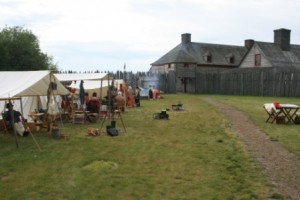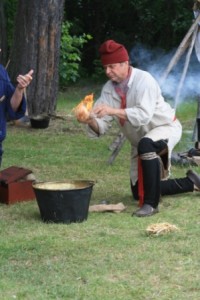Carrying canoes and tons of cargo 8 ½ miles around the rapids of the Pigeon River, and this was the easy route! This place earned its name.
We visited Grand Portage National Monument for a living history lesson on the fur trade of the late 1700s. New lands were explored, routes were found to remote and distant places; and at least in the early times, it created a cultural melting pot for many nationalities and the native Ojibwa. All for the want of a beaver felt hat!
It was rendezvous weekend.  Re-enactors and park staff were in period dress and living the lives of Fur Trade captains of the northwest Trading Co., Voyageurs, Dakota Indians, Ojibwa Indians, and the families that followed them.
Re-enactors and park staff were in period dress and living the lives of Fur Trade captains of the northwest Trading Co., Voyageurs, Dakota Indians, Ojibwa Indians, and the families that followed them.
We were entertained by a bagpiper.  Journals and historical accounts make note of their actually being a piper at the camp to entertain. Who would have thought? A tin smith held a class to teach how to make a fire lighting glass holder. Around one hundred individuals, young kids to retired folks like us (or even older) filled canvas tents, played games of the time, stitched, carved, wove, and cooked over open fire. Some were purists and strove to live entirely within the constraints of the time so they even used only the dried foods available of the period in this setting. These folks seem to love the adventure of it. Every time we go to one of these we think, “that would be fun”.
Journals and historical accounts make note of their actually being a piper at the camp to entertain. Who would have thought? A tin smith held a class to teach how to make a fire lighting glass holder. Around one hundred individuals, young kids to retired folks like us (or even older) filled canvas tents, played games of the time, stitched, carved, wove, and cooked over open fire. Some were purists and strove to live entirely within the constraints of the time so they even used only the dried foods available of the period in this setting. These folks seem to love the adventure of it. Every time we go to one of these we think, “that would be fun”.
Did you know that your can start a fire in less than 10 seconds, maybe even in 5.8?  Well some people can. In the Voyageurs’ camp they held a fire starting competition. Armed with a flint, steel, a bit of char cloth and a nest of finely frayed hemp rope each tried their hand a starting a fire. First strike of the flint rock to first flame was timed. Incidentally, the record 5.8 today was accomplished by a woman. I can’t do that with a match!
Well some people can. In the Voyageurs’ camp they held a fire starting competition. Armed with a flint, steel, a bit of char cloth and a nest of finely frayed hemp rope each tried their hand a starting a fire. First strike of the flint rock to first flame was timed. Incidentally, the record 5.8 today was accomplished by a woman. I can’t do that with a match!
Indian birch bark canoes are an absolute marvel that they freely shared with the newcomers. The white-man-built version on steroids (38 feet long) was the key to success of the fur trade. Disgraceful stories of forced marches, reservations, and unkept promises tell of how the Ojibwa were repaid. It leaves a bit of a sour taste.
